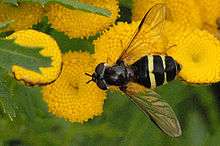Dasysyrphus tricinctus
| Dasysyrphus tricinctus | |
|---|---|
 | |
| male | |
 | |
| female | |
| Scientific classification | |
| Kingdom: | Animalia |
| Phylum: | Arthropoda |
| Class: | Insecta |
| Order: | Diptera |
| Family: | Syrphidae |
| Genus: | Dasysyrphus |
| Species: | D. tricinctus |
| Binomial name | |
| Dasysyrphus tricinctus (Fallén, 1817) | |
| Synonyms | |
| |
Dasysyrphus tricinctus is a european species of hoverfly in the genus Dasysyrphus, a member of the family Syrphidae.[1][2] It is found across Europe, although reported in highest density from the British Isles and Scandinavia. While not uncommon it is generally only seen in modest numbers, typically in lowland woods with peak numbers in late May and early June and again in late August and early September.
Description
External images
For terms see Morphology of Diptera
Wing length 7·25-10·25 mm.
Eyes hairy. Wing stigma black.Tergite 3 with yellow pattern much broader than on tergite 4 and yellow pattern on tergite 2 small or absent/[3]
[4]
[5] [6] Male genitalia are figured by Hippa (1968) .[7]
The larva is illustrated by Rotheray (1993) [8]
Distribution
Palaearctic .Iceland South to the Pyrenees and North Spain.Ireland and Fennoscandia eastwards through Central and North Europe and Russia to the Pacific coast and Japan.[9] [10]
Biology
Habitat:deciduous forest, coniferous forest and conifer plantations,Picea plantations, scrub Betula, tracksides, clearings, parkland.[11] Arboreal, but descends to visit flowers of yellow composites and white umbellifers Calluna, Campanula, Convolvulus, Cornus, Euphorbia, Geranium, Parnassia, Plantago, Polygonum, Ranunculus, Sedum, Sorbus, Stellaria, Succisa, Valeriana.[12] The flight period is April to October in two generations.The larva has been observed feeding on sawfly larvae on Picea and Lepidoptera larvae.
References
- ↑ Stubbs, Alan E.; Falk, Steven J (1983). British Hoverflies: An Illustrated Identification Guide (2nd ed.). London: British Entomological and Natural History Society. pp. 253, xvpp. ISBN 1-899935-03-7.
- ↑ Ball, S.G.; Morris, R.K.A. (2000). Provisional atlas of British hoverflies (Diptera, Syrphidae). Monks Wood, UK: Biological Record Centre. pp. 167 pages. ISBN 1-870393-54-6.
- ↑ Van Veen, M. (2004) Hoverflies of Northwest Europe: identification keys to the Syrphidae. 256pp. KNNV Publishing, Utrecht.addendum
- ↑ Van der Goot,V.S. (1981) De zweefvliegen van Noordwest - Europa en Europees Rusland, in het bijzonder van de Benelux. KNNV, Uitgave no.32: 275pp. Amsterdam.
- ↑ Bei-Bienko, G.Y. & Steyskal, G.C. (1988) Keys to the Insects of the European Part of the USSR, Volume V: Diptera and Siphonaptera, Part I. Amerind Publishing Co., New Delhi. ISBN 81-205-0080-6.
- ↑ Coe, R.L. (1953) Diptera: Syrphidae. Handbks.ident.Br.insects, 10(1): 1-98. R.ent.Soc.London. pdf
- ↑ Hippa, H. (1968) A generic revision of the genus Syrphus and allied genera (Diptera: Syrphidae) in the Palearctic region, with descriptions of the male genitalia. Acta Ent.Fenn., 25: 1-94.
- ↑ Rotheray G., 1993 Colour Guide to Hoverfly Larvae Diptera, Syrphidae in Britain and Europe Dipterists Forum pdf
- ↑ Fauna Europaea
- ↑ Peck, L.V. (1988) Syrphidae. In: Soos, A. & Papp, L. (eds.) Catalogue of Palaearctic Diptera, 8: 11-230. Akad.Kiado, Budapest.
- ↑ Speight, M.C.D. (2011). "Species accounts of European Syrphidae (Diptera)" (PDF). Syrph the Net, the database of European Syrphidae. 65: 285pp.
- ↑ de Buck, N. (1990) Bloembezoek en bestuivingsecologie van Zweefvliegen (Diptera, Syrphidae) in het bijzonder voor België. Doc.Trav. IRSNB, no.60, 1-167.